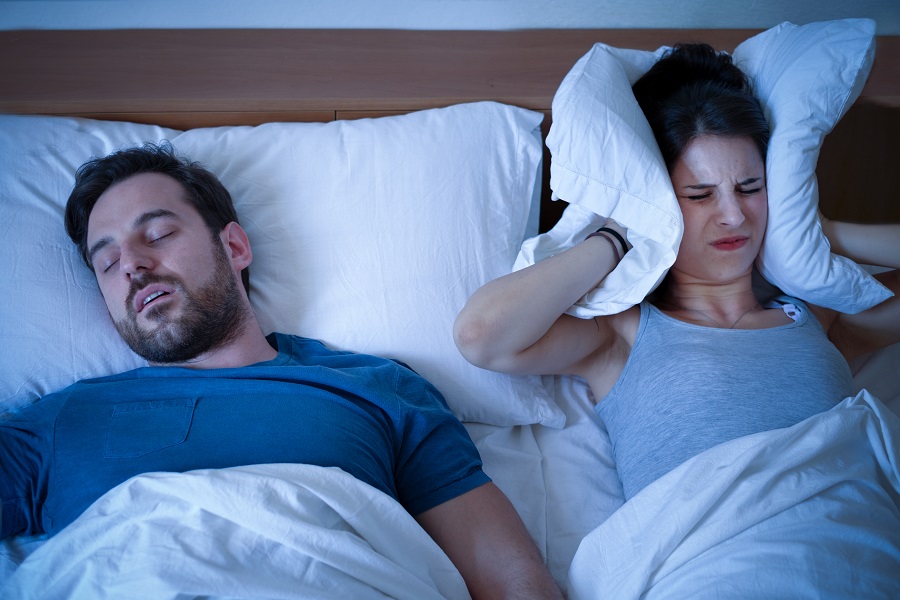Sleep Apnea: Is It "Just" Snoring or Something More Serious?

We know sleep is important to our well-being. But getting it can be challenging. Stress, caffeine and poor work/life balance can interfere a restful night. But sleep apnea — a serious, potentially life-threatening disorder — can also be the culprit.
One of the chief causes of non-restful sleep is snoring – an issue in which its potential seriousness is underrated. Snoring occurs when the muscles in our airway relax and collapse, causing a narrowing in the throat and the rear of the mouth. As air flows past the relaxed tissue, it vibrates, causing a coarse or harsh sound.
When that tissue becomes too loose, it can collapse, blocking our airway and interrupting breathing, causing a condition known as obstructive sleep apnea.
What Is Sleep Apnea?
There are three types:
Obstructive sleep apnea happens when air can't flow into or out of the nose or mouth, although efforts to breathe continue.
Central sleep apnea is when the brain fails to signal the muscles to start breathing. Central sleep apnea is less common than obstructive sleep apnea.
Complex sleep apnea combines the symptoms found in both central and obstructive sleep apnea.
Sleep apnea causes involuntary breathing pauses or "apneic events" that occur five to 30 or more times per hour. It can also make you feel like you're choking. The frequent interruptions often lead to early morning headaches and excessive daytime sleepiness. Other symptoms include dry mouth, sore throat and problems paying attention.
The Anatomy of An Apneic Event
During the apneic event, you can't breathe in oxygen or exhale carbon dioxide, causing decreased levels of oxygen and increased levels of carbon dioxide in the blood. This condition alerts the brain and causes arousal. Each arousal sends a signal from the brain to the upper airway muscles to open the airway. Breathing resumes, often with a loud snort or gasp. Frequent arousals, although necessary for breathing to restart, prevent restorative, deep sleep.
Early recognition and treatment of are important because it may be associated with the following:
- Irregular heartbeat
- High blood pressure
- Heart attack
- Stroke
- Daytime sleepiness
- Increased risk of motor vehicle accidents
Who Is at Risk for the Condition?
The condition seems to run in some families, suggesting a possible genetic basis. People most likely to have or develop it include those who:
- Snore loudly
- Are overweight
- Have high blood pressure
- Have some physical abnormality in the nose, throat or other parts of the upper airway
The use of alcohol and sleeping pills increases the frequency and duration of breathing pauses.
How Is It Diagnosed?
Your primary care provider, pulmonologist, neurologist, otolaryngologist or other health care provider with specialty training in sleep disorders can help.
Evaluations usually involve overnight monitoring of your breathing and other body functions using tests such as:
- Polysomnography. Carried out in a sleep lab, this test records various body functions during sleep. They include the brain's electrical activity, eye movement, muscle activity, heart rate, respiratory effort, airflow and blood oxygen levels.
- Home sleep apnea test. This test is done with a portable device that can diagnose sleep apnea. Your doctor will arrange for you to take it home to wear during sleep and then return it to the office, where the results are processed.
How Is Sleep Apnea Treated?
Treatment will depend on your symptoms, age, general health and the severity of the condition. Treatments include:
CPAP machine. A CPAP, or continuous positive air pressure machine, delivers a constant flow of air under pressure to stent your airway open, with air delivered by either a nasal piece or a face mask while you sleep.
Behavioral changes. In mild cases, you may be advised to:
- Stop using alcohol or tobacco.
- Stop using sleeping pills.
- Lose weight if overweight. Even a 10% weight loss can reduce the number of sleep apnea events for most people.
- Use pillows and other devices to help you sleep on your side if you usually sleep on your back.
- Dental appliances that reposition the lower jaw and the tongue have been helpful for some people with mild sleep apnea or who snore but don't have apnea.
Surgery. Some people with sleep apnea may need surgery. Examples of these procedures include:
- Surgery to remove adenoids and tonsils, nasal polyps, or other growths or tissue in the airway or to correct structural deformities
- Surgery to remove excess tissue at the back of the throat (tonsils, uvula or part of the soft palate)
- Surgery to reconstruct deformities of the upper and lower jaw
- Surgery to treat obesity
Nerve stimulator. A newer treatment option for certain people is called a hypoglossal nerve implant. The device stimulates your tongue to open your airway when you breathe in while sleeping.
When Is it Time to See a Health Care Provider?
Symptoms include:
- Loud snoring
- Instances when you stop breathing during sleep
- Gasping for air during sleep
- Waking up with a dry mouth
- Headaches in the morning
- Difficulty staying asleep, known as insomnia
- Excessive daytime sleepiness, known as hypersomnia
- Difficulty paying attention while awake
- Irritability
If you or your partner notice any of these symptoms occurring regularly, be sure to discuss them with your health care provider.
Related: Sleep Deprivation in Teens

